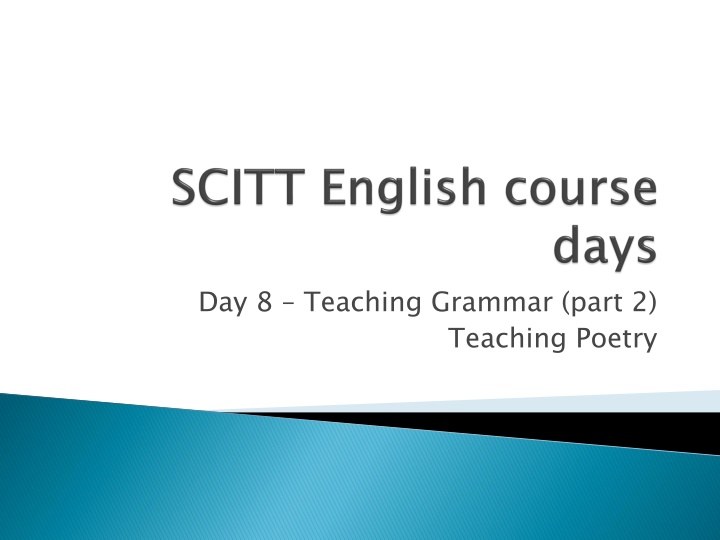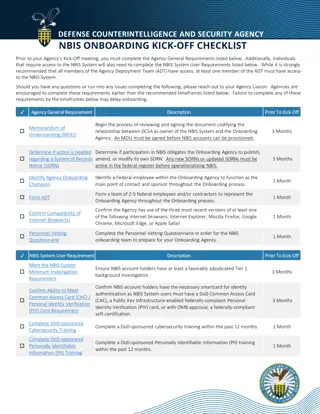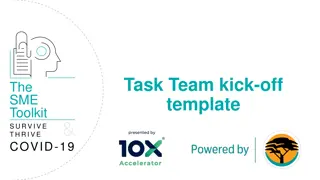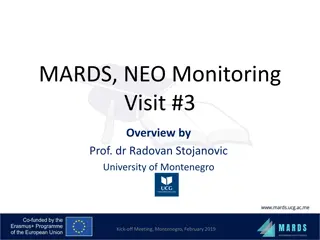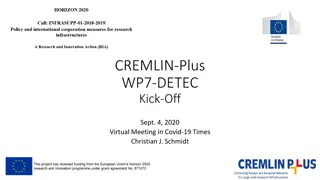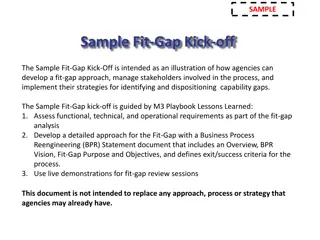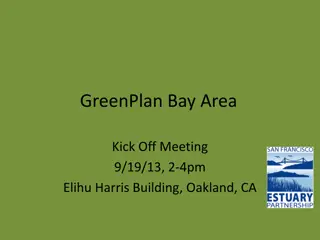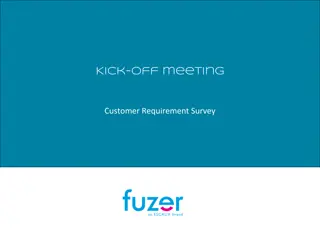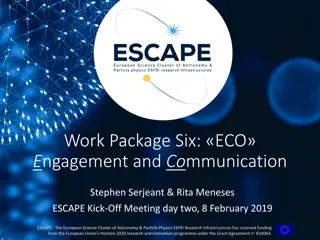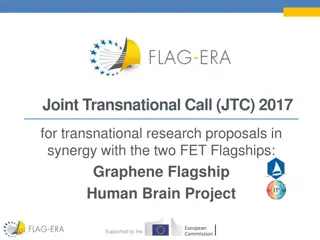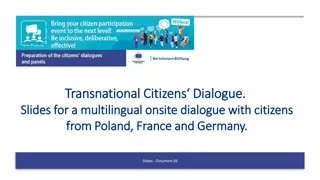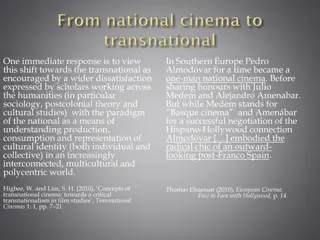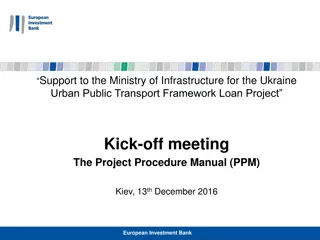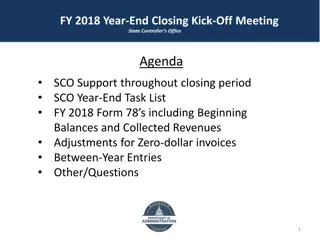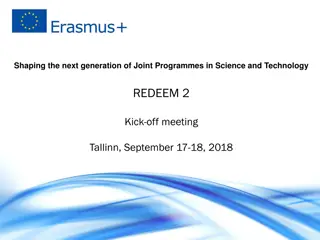SAFE Online Kick-Off Meeting for Europe - Transnational Partner Meeting
This project focuses on SAFE streaming approaches for school education during COVID-19, emphasizing eLearning acceptance, teacher training, implementation in schools, and creation of didactic materials. It aims to enhance streaming tools for better learning outcomes and offers a comprehensive overview of the project's intellectual outputs and objectives.
Download Presentation

Please find below an Image/Link to download the presentation.
The content on the website is provided AS IS for your information and personal use only. It may not be sold, licensed, or shared on other websites without obtaining consent from the author.If you encounter any issues during the download, it is possible that the publisher has removed the file from their server.
You are allowed to download the files provided on this website for personal or commercial use, subject to the condition that they are used lawfully. All files are the property of their respective owners.
The content on the website is provided AS IS for your information and personal use only. It may not be sold, licensed, or shared on other websites without obtaining consent from the author.
E N D
Presentation Transcript
Day 8 Teaching Grammar (part 2) Teaching Poetry
Which word classes? Hal and Lucy slowly undid the knot It was very tight Eventually, the present was opened Nestled in some tissue paper was a golden hare
Which word classes? Hal and Lucy slowly undid the knot Noun, conjunction, noun, adverb, verb, determiner, noun It was very tight Pronoun, verb, adverb, adjective Eventually, the present was opened Adverb, determiner, noun, verb, verb Nestled in some tissue paper was a golden hare Verb, preposition, determiner, adjective, noun, verb, determiner, adjective, noun
Complete your reading wall. Select one book and use the teaching sequence for writing to plan how you could use this in a unit of work for key stage 1 or 2. Standard 2d - Demonstrate knowledge and understanding of how pupils learn and how this impacts on teaching http://dpgitr7uxxopj.cloudfront.net/wp-content/uploads/man-reading-against-stone-wall-4427007009-800x533.jpg
During your second placement teaching practice you must plan, teach and evaluate a sequence of lessons for a specific unit of work in Choose a unit of English for your teaching sequence that develops pupils literacy skills Research effective learning and teaching approaches/ideas to help plan and deliver this unit Plan an effective learning sequence Teach the learning sequence Evaluate the impact on pupils learning Consider implications for future teaching & learning During your second placement teaching practice you must plan, teach and evaluate a sequence of lessons for a specific unit of work in English English
During your second placement teaching practice in EYFS you must plan, teach and evaluate a sequence of adult led and child led activities to develop pupils English skills Research effective learning and teaching approaches/ideas to help plan and deliver English in EYFS Design and plan an effective sequence of learning experiences based on this research that will develop pupils English skills Teach the sequence Evaluate the impact on pupils learning Consider implications for future teaching and learning During your second placement teaching practice in EYFS you must plan, teach and evaluate a sequence of adult led and child led activities to develop pupils English skills
Choose up to three investigate (just one aspect investigated in depth is acceptable and may well be preferable); they should be approaches to teaching rather than just general educational issues. These could be aspects of English teaching (e.g. use of drama to develop reading comprehension, use of film to inspire writing, use of modelled writing to improve grammar, etc.) or they could be more generic (use of questioning, use of AFL etc.). Don t be tempted to research too many areas. You need to research your chosen focus area(s) using appropriate source material. This may be educational books, websites or articles in journals. They should be scholarly (NOT TES resources, BBC bitesize etc.) Try to find a variety of sources (certainly more than one) and If possible, try to give more than one point of view on the approach. up to three focus areas which you wish to
You will: Develop understanding of grammatical terminology Examine strategies to teach grammar Know how to teach poetry Know poetic techniques and forms
Shared reading Modelling Oral rehearsal (think it, say it, write it, check it) Children should be able to at least write some sentences by the end of YR The main objective at the beginning of Y1 is to write a series of sentences 10
Early writing instruction (day 6) Instruction in guided writing Picture stories (day 6) Sentence halves Missing words Rainbow sentences Blu-tak full stops Proof reading Sentence / not sentence 11
Statement (telling sentence) The film started on time. Question (asking sentence) Why did you take my coat? Command (ordering sentence) Please switch it off. Exclamation (excited sentence) What a huge house that is!
Sentence Clauses Phrases Words
Phrase - a group of words grammatically connected so that they stay together They expand a single word Noun phrase her red car Preposition phrase She put it in her red car Clauses are groups of words with a subject and a verb They can be Main subordinate her red car in her red car verb She was She was driving driving
Clauses have four main elements in the primary curriculum Subject Verb Object Adverbial And one that isn t included: complement They can each appear in different lengths and structures.
Subject Tells you what the sentence is going to be about Verb Tells you what s happening Object The thing most affected by the action of the verb Adverbial Tells you more about the verb or whole clause Complement Tells you more about the subject or object
The most common sentence constructions are: SV - The dog slept SVO The dog ate the cheese SVOO The dangerous dog gave the man a bite SVC The dog was excited SVOC The dog licked the bowl clean
These can go all over the place! SVA - The dog slept peacefully SAVO The dog thoughtfully ate the cheese ASVOO In much excitement, the dangerous dog gave the man a bite ASVC Unusually, The dog was excited ASVOCA However, the dog licked the bowl clean in under a minute
Sam wrote the speech. Toby gave his glasses a good clean. Suddenly, Jed stopped. Josh was sleeping quietly. An irritated Leo slammed the office door. Before nine o clock, Charlie had written five letters at his desk
Sam wrote the speech. Toby gave his glasses a good clean. Suddenly, Jed stopped. Josh was sleeping quietly. An irritated Leo slammed the office door. Before nine o clock, Charlie had written five letters at his desk
Who or whom Who is always the subject (like he and they ) Whom is never the subject (like him and them ) You can use he , they , him and them as a check Always use whom after prepositions You sat by ... all night? With ... did you see the film? ... paid for the tickets? He is an old man ... lives by the river That is the lady to ... I made the promise Who or whom
Simple sentence one clause Complex sentence (uses subordination) one main clause and one or more subordinate clauses Compound sentence (uses co-ordination) two main clauses of equal weight 22
Because Whenever Since Before While As After Until When Where ... And But Or Co-ordinating Subordinating
The big dog was barking The big dog was barking the Hallelujah Chorus. The big dog was barking The big dog was barking the Hallelujah Chorus in the At midnight last Wednesday, the big dog was barking the big dog was barking The big dog was barking garden. behind Buckingham Palace. The big dog was barking. the Hallelujah Chorus, rather wistfully, in the garden 24
Before she starts work, Mrs Goodfellow does her relaxation exercises. Mrs Goodfellow had forgotten all of the gossip that Mrs Barker had told her The cat, which was called Dave, stared at Mrs Goodfellow. Mrs Goodfellow took a deep breath because this, at last, was her moment.
A type of subordinate clause that modifies the noun (or another clause) usually by using relative pronouns e.g. Jack, who had chickenpox, stayed in bed. Try adding them in: The man was ill The film was terrific Rufus left the building The book rose into the air Sometimes the pronoun might be ellipted improve flow e.g. The car I bought is lovely. ellipted to
The omission of a word or phrase necessary for a complete syntactical construction but not necessary for understanding Bob drove up the ramp and he put his foot down She did it because she wanted to do it I like coffee but I hate tea The dog which was called Gerald was racing around the garden A mark (usually ...) to indicate omission of letters or words
Write complex sentences starting with Although Because Despite After Each must contain both the word camel and the word coconut
The lady stuck our her elbows and pushed past. Jabbing at people with a small umbrella, she carved her way through the crowds to her front gate. Strangely, when she saw what Mr Somerville had achieved, she was no more pleased than before. Her face changed to an interesting mandarin colour. From Six Storey House by Geraldine McCaughrean
Show me: A simple sentence about Harry Potter A compound sentence about The Queen A complex sentence about someone on your table
Short to build tension Long to add information Question to draw the reader in Sentence of three to give a mental picture Sentence containing an ing clause to add supporting action Exclamation To grab the reader s attention 31
Clear grammar knowledge and use of the terms Varying the types of sentence Adding adverbial phrases and clauses Expanding noun phrases Crafting sentences for effect 32
Text analysis In context Modelling in shared writing Using the terminology Human sentences Peer assessment Sequencing Using whiteboards Supported composition 33
Grammar in action Look at child s writing .. Which grammatical features are they secure in? What does the child need to focus on next in terms of grammar? 34
The enjoyment of, and playing with, language is essential if we are going to use it to good effect Poetry reveals the beauty of language Manipulating words means that the child can control them rather than the words controlling the child The brevity and compression of poetry appeals and leads to tighter crafting It enables children to explore ideas, feelings and emotions
2 key types Free verse Structured Also Visual Narrative Performance Nonsense
Prediction tasks Questioning Annotating Sequencing Cloze Readers theatre Memorising poems Linking to own experience Analysis grid
Hate glared in their eyes Like unexploded neon Moon-curdling moans Aching snow Ripped at roofs, tore at chimneys Sleep calling beds All was quiet
What is the poet trying to do? How are they doing it?
To make you laugh To make you aware To paint a place To paint a moment To make you feel... To make you think To tell a story To capture the essence of something To delight the reader To create an atmosphere Creepy Bleak Serene ... To make you enjoy the sound of the poem To communicate a meaning
Alliteration Repetition Imagery Similes Onomatopoeia Metaphors Personification Assonance Consonance Symbolism Meter and feet for rhythm
Images relate to senses Sometimes images can relate to many senses e.g. Rain Practise building images e.g. a daffodil a shining daffodil a shining daffodil in the sun a shining daffodil in the sunlit kitchen
A surfer A robin A piano A clown A streetlamp A diary A piglet
Add similes to give a creepy atmosphere A drooping branch hung like... The room was as cold as... The spiders darted through the cracks like... The strange twins were...
Add similes to make the reader laugh She strode through the room like... The thin man was like.. The startled cat... When they danced they were like...
He stood... His face was... His eyes... His suit... His mind...
Summer is a cigarette, Inhaled until it has nothing left to give, And the charred remains are left To make a smoky pillar of autumn. Mark Nathan
